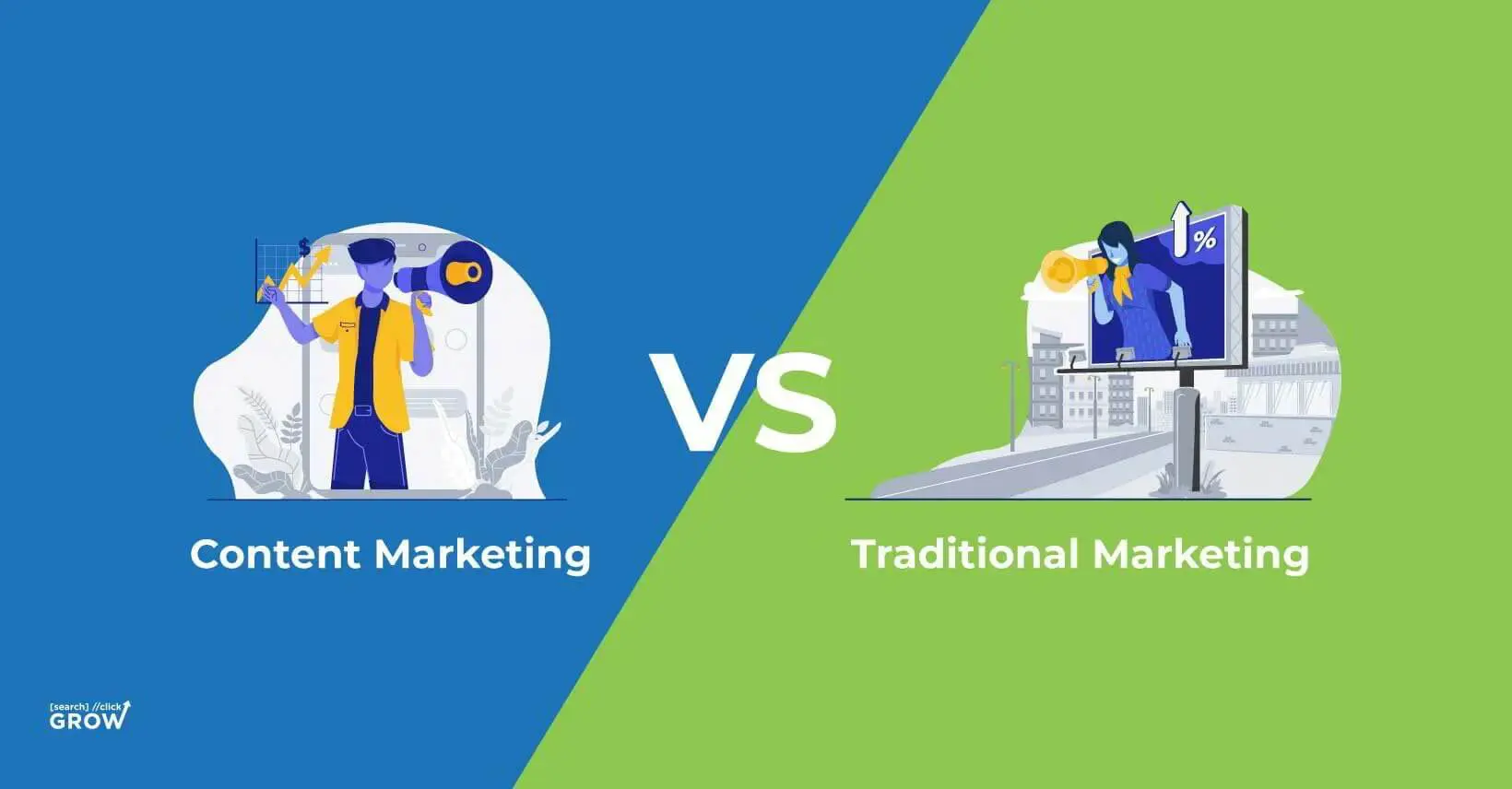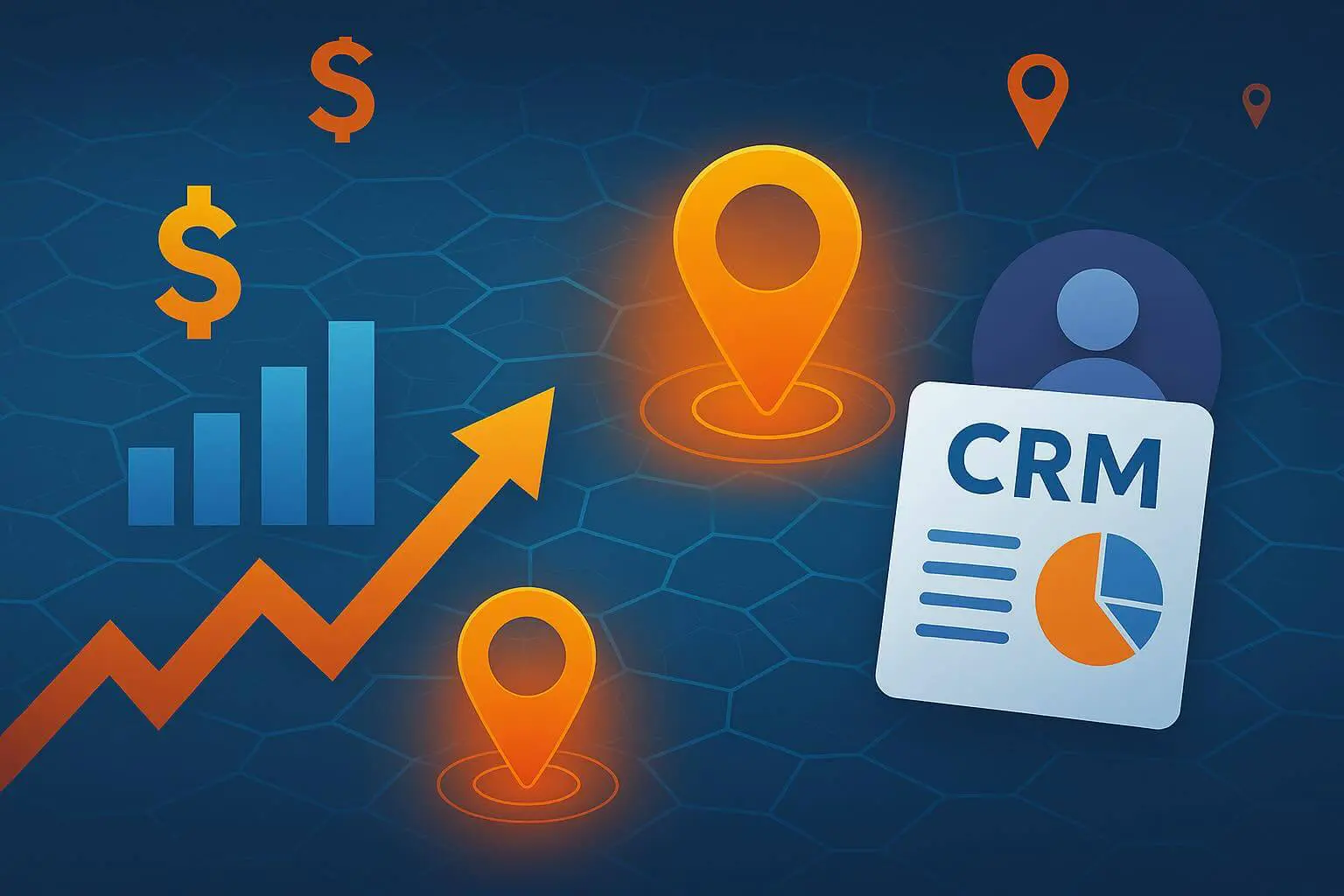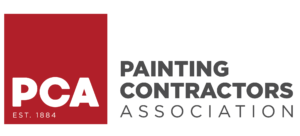
Content Marketing vs Traditional Marketing: Pros & Cons
Every business uses marketing strategies to gain visibility and sell, but the differences between content marketing vs traditional marketing are rarely discussed.
Most marketing departments conflate the two, which isn’t always the best practice.
Content marketing is very different from traditional marketing methods, such as pop-ups and paid online advertising.
When considering which marketing strategy is best for your business, you’ll need to take a deeper look and see which adds more value from the perspective of your prospects and customers.
We have written this article to show you the pros and cons of each strategy.
Ultimately, you’ll learn which is better:
- Communicating to customers without selling OR Interrupting customers with a deal they can’t turn down.
Traditional Marketing vs Content Marketing: A Difference in Strategy
There are mainly two goals with any marketing strategy:
- Gain more visibility with the right customers.
- Convert like crazy. Both content marketing and traditional marketing strategies offer ways to do this.
However, content marketing is a slower, more thoughtful process, while traditional marketing is more about audience targeting and reaching a wider audience quickly even when they haven’t necessarily asked to see your marketing.
Both can work for your business depending on the strategies are used and paired with creative visuals and messaging.
However, you may just find that content marketing hits a sweet spot that keeps delivering conversions from new and returning customers.
Let’s break these two marketing approaches down with pros and cons:
What Is Traditional Marketing?
Traditional marketing is described by professional marketers as any strategy that interrupts your customers to show an advertisement. This is why marketing is often just called advertising.
A brand that uses traditional marketing may create:
- A TV commercial
- Magazine ads
- YouTube ads
- Facebook feed ads
- Brochures, or other ads to reach audiences
Many brands create buyer personas and use new targeting methods to deliver ads straight to their most “qualified” customers, while others use locations or markets to create demand via broader reach advertising.
For example, national commercials target designated market areas (DMAs) to generate demand.
The whole goal of this strategy is to quickly gain visibility and strategically interrupt the right customers to elicit interest, thereby gaining a conversion. This method works well when you’ve done a ton of market research and know that your audience will be so enticed by the deal that they won’t mind being interrupted.
Below, we’ll look at why this interruptive approach may work and why it can also discourage customers from buying your products.
What Is Content Marketing?
Content marketing is often called inbound marketing whereby a brand places different pieces of content across multiple channels, then waits for customers to follow the funnel to a purchase.
Content is published in various formats, such as:
- Blogs
- Videos
- eBooks
- Social Media
- Press Releases
- Email Marketing
This content is published in different locations, hoping to attract audiences who relate to the content and want to learn more.
How Is Content Marketing Different from Traditional Marketing?
Instead of using promotions and advertising, content marketing typically starts with a blog post or landing page that provides helpful information to the customer.
This information builds trust with your visitors, who you hope will return to learn more or even click through to find helpful products on your website.
- The typical goal for any first-time content marketing campaign is an opt-in from your customer, where you ask for your prospect’s email address. Once a brand confirms this sign-up, the prospect is now on your email marketing list. This allows you to send more direct marketing materials and promotions, as well as other educational materials.
- After a customer agrees to opt-in, they’ve given you permission to send more information their way, but you’ll need to be careful as this is the first step of trust-building with your customer. If you want to nurture them, you’ll have to send personalized email content and guide them a bit more through your sales funnel.
Thus, content marketing is ultimately a long-term, SEO-driven strategy that continuously nurtures visitors and prospects into long-time customers.
Different Marketing Approaches: Permission vs. Interruption
One of the main differences between content marketing and traditional advertising is the idea of permission and interruption.
Permission in Marketing
These relationships are predicated on trust, so you’ll have to nurture these customers if they don’t instantly convert after reading your blog or landing page that mentions a specific product or service.
In some cases, the funnel is very short, and after a brief read-through, customers actively look for offers and products to purchase from you.
This is ideal but not typical for new brands or freshly launched products that your customer is simply researching before making a purchase.
It’s also dependent on the commitment of the buyer.
- Is it a higher cost?
- Does it require setup?
- Is it as easy to use as a competitor product?
These are all questions and objections that should be answered within your content marketing campaign to make it easier for your customer to convert quickly.
Interruption in Marketing
Traditional advertising is meant to disrupt the customer.
However, before the age of internet ads, many brands used TV commercials, print, or direct mail to offer irresistible deals that customers could consider.
Due to the cost and ad requirements, start-ups and small businesses weren’t always able to compete beyond a local audience.
That isn’t the case anymore.
Thanks to social media advertising, Google display network, and search engine ads, traditional advertising is everywhere and can target just about anyone for any product they may be interested in.
However, customers are actively trying to block ads and see fewer ads all the time.
That’s because these ads interrupt them and don’t always feel relevant to their lifestyles and needs. This is where market research, buyer personas, and fast online checkout experiences really matter.
For traditional advertising to work, the ad must be visually stunning with on-point messaging that directly pulls the customer into the offer and shows them why it’s so great in just a few seconds.
If you target the right audiences, there’s less of a chance that your ad will be hidden or ignored.
Contrasting Pros and Cons: Content Marketing vs Traditional Marketing
So which marketing strategy should you choose? It’s not always that simple.
Most businesses use a combination of content marketing for long-term trust-building while also incorporating some traditional marketing campaigns to gain visibility and conversions at a faster rate.
We’ve broken down the highlights of each marketing strategy as well as some of the disadvantages below with pros and cons.
Pros of Content Marketing
- Builds trust and long-term relationships with customers
- Better for returning customers
- Works for both B2B and B2C audiences
- Brings in more qualified leads
- Increases chances of “going viral”
- Attracts customers looking for reliable information
- Ongoing, long-term “free” marketing and SEO
- Analytics helps you hone strategy and re-allocate budget to what’s working over a longer period of time
Cons of Content Marketing
- Longer sales funnel
- Not as fast as traditional advertising
- Requires planning and time to execute
- Needs creatives, copywriters, and SEO experts
- Offers must reflect audience needs
- Hard to measure effectiveness, requires Google Analytics and other data tools
Who Should Use Content Marketing?
For small businesses or marketing teams on tight budgets, content marketing offers some significant benefits. However, larger businesses can use these inbound marketing methods to their advantage as well.
Most brands using content marketing need to build more trust with customers. Either your brand is new or just getting started on social media, and you’ll need great content to capture your audience’s attention.
Inbound marketing pages and blogs should focus on informing customers, giving them all the information they need to learn more about the product and service without trying to sell a deal.
However, you can still put an offer out there to excite customers and get them thinking about the next steps. This is called a lead magnet, and it’s typically a downloadable free gift.
To get the free gift, customers have to sign up or opt-in with an email address. Once the do so, you now have direct access to this customer.
- You’ll need to build upon that trust by completing the free gift offer.
- Then you can start nurturing this prospect into a long-term customer.
If you don’t have time to set up these offers but need more traffic and visibility right away, you’ll likely be better served with a traditional marketing campaign.
However, there are some budget requirements to consider before jumping on this approach.
Pros of Traditional Marketing
- Fast, measurable results
- Quicker conversions typically
- Best for raising awareness and visibility
- Flexible and changeable, test and re-test to create new opportunities
- Great for new customer acquisition or re-engaging older customers
- Uses audience targeting to reach the most likely to convert
- Excellent for high-value products and services for B2B
- Harder to ignore
Cons of Traditional Marketing
- Higher risk (but may also be higher rewards)
- High costs: campaigns require significant daily/monthly budgets and creative costs
- Market research and execution is essential, otherwise can lead to missed opportunities or failure, resulting in budget deficits
- If not planned correctly, only leads to one-way communication that consumers did not ask for
- High social exposure if mistakes are made, may lead to social media backfire
- Requires ad management and bid monitoring knowledge, which can be complicated on certain advertising networks
Who Should Use Traditional Marketing?
Traditional marketing is for those who have a great message, easy-to-understand products or services, and more budget for marketing costs.
This approach still requires a lot of time due to market research and audience targeting, but the conversions typically come faster because you’re advertising directly to your customer’s feed on multiple channels.
The beauty of using traditional advertising channels is that they can find and follow your consumers. But, if your messaging isn’t right or your audience simply doesn’t like your ad, there’s a high risk that you’ll lose budget on campaigns that won’t work.
This is why research, testing, and analytics are so important to traditional advertising.
These campaigns also require detailed setup and management. If your sales are dropping and you’ve sent out your best deals via banner ads or search ad campaigns, you’re probably losing customers at some point in your funnel.
It could be your landing page doesn’t show correctly on mobile or it could be that your offer just isn’t as good as a competitor’s deal.
You’ll need a campaign manager to monitor and measure these campaigns for higher returns and ongoing conversions.
Which Marketing Strategy Works Better for Your Business
As you can see, both methods require some commitment and budget.
If you are thinking of a new marketing strategy, there are ways to combine the best of both worlds for demand generation campaigns that lead to more thoughtful interactions with customers.
Ultimately, this approach works for a variety of businesses, but it takes research and budget consideration to truly understand what methods are best for your business.
For businesses with less budget to devote to advertising who aren’t looking for quick conversions, it may be cheaper and more effective to go with content marketing over traditional methods.
However, if you are struggling to gain visibility and traffic, traditional marketing and advertising can certainly help you get in front of the right audience.
We’d love to help you with a customized strategy that combines the best of inbound marketing and online advertising. Learn more about our marketing approach so your business can reach customers today.






